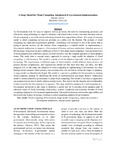| dc.description.abstract | As Governments look for ways to improve service provision, the need for restructuring processes and effectively using technology to improve efficiency and effectiveness of their functions becomes critical. Cloud computing is one of the recent technological trends that support these efforts. It is a type of sourcing model in which computing services are provided as a utility over the Internet. The promise of cloud computing has captivated organizations globally. Considering e-Government is one of the sectors that is trying to provide services via the internet, cloud computing is a suitable model for implementing eGovernment architecture to improve e-Government efficiency and user satisfaction. Adoption process is the challenge. Organizations have challenges of how to best adopt cloud computing. Existing frameworks of cloud adoption look at different aspects of cloud but fail to view the complete spectrum of cloud adoption issues. This study takes a concept centric approach by creating a stage model for adoption of cloud computing in e-Government. The model is a guide on cloud adoption, especially with the dynamics of technology. The organizations at different stages of cloud adoption exhibit different characteristics and possess distinct competencies, and organizations should not bite more than they can chew, lest their programs fail. In this study, the adoption of cloud computing in implementing e-Government was done through mixed research, where primary and secondary data was utilized to inform the stages of adoption. A stage model was therefore developed. The model is to provide a guideline for Governments in creating cloud-computing strategy by identifying the levels of implementation and stages thereof. Deployment model is mostly utilized by governments to adopt cloud computing. This model is not clear on application and progression nor does it clearly address security issues. This puts at risk the integrity and confidentiality of data owned by the Government or its agencies. The stage model for adoption of cloud computing in eGovernment developed in this study is therefore a useful tool for it provides cloud adoption path. It addresses issues of cloud ownership, cloud policy, systems complexity and economic benefits of cloud computing adoption in e-Government implementation. The model evaluation confirms the applicability and the central role it plays on laying a roadmap to cloud computing adoption for governments | en_US |

